Easy Way to Kill a Nest Factorio
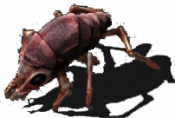
Enemies (also commonly called Biters) are creatures that desire to harm the actor. They are the native inhabitants of the extraterrestrial world in the form of arthropods living in organic nests, coexisting with each other peacefully. They are encountered in three species: Biters, spitters and worms. The species are further distinguished in four stages of growth, and thus force. Enemies and nests show up on the map equally red dots. Much like the histrion, enemies can slowly regain lost health.
Contents
- 1 Achievements
- 2 Creatures
- ii.1 Biters
- two.2 Spitters
- 2.3 Worms
- 3 Nests
- 3.i Expansions
- iv Defense
- v Evolution
- 5.one Methods of increasing
- five.two Spawn chances past evolution cistron
- 5.3 Advanced: Evolution factor components and computation
- 6 Gallery
- 7 History
- eight Run across also
Achievements
Enemies are directly connected to the following achievements:
Creatures
Biters
Biters are one of two main antagonists in the game. They come in four sizes: small, medium, big and behemoth. In the outset of a game, there will only exist the minor ones. With increasing pollution, they will become bigger, related to the enemy'south evolution. As mutual sense may propose, their method of attack is a straightforward charge to "bite" things.
| Movie | Proper noun | Info |
|---|---|---|
| | Small-scale Biter | Weakest of biters, can be easily killed with a pistol.
|
| | Medium Biter | Stronger and slightly faster than the small biter. Can pose a problem for and even kill weaker players.
Resistances:
|
| | Big Biter | Dangerous, resistant to pocket-size artillery. Can set on through walls, hit objects directly backside them.
Resistances:
|
| | Behemoth Biter | Extremely durable and nearly allowed to small arms, except for the strongest ordnance. Can set on through walls, hitting objects directly behind them.
Resistances:
|
Spitters
Spitters are much similar biters and only appear slightly afterward in the game as the evolution gene increases. Their master difference from biters is their ranged assail. Using predictive aiming, they spit a stream of acid at enemies which leaves backside a puddle of acrid where it hits the ground. Due to the spitters' predictive aiming, the acid stream can be dodged by all of a sudden irresolute walking directions or continuing however.[i] Both the stream and the puddle of acid deal impairment of time and slow down players and vehicles. Most entities of the game have a much lower resistance to acid than other impairment types (including turrets and armor), and then spitters are effectively more potent against the player and their factories. Their behaviour and size classification are the same every bit with biters, but their wellness is universally lower and they are resistant exclusively against explosives, with no physical resistance.
| Picture | Name | Info |
|---|---|---|
| | Small Spitter | Weakest of spitters. Easy to kill with whatever weapon, simply attacks at range.
Acid projectile:
Acrid puddle:
|
| | Medium Spitter | Stronger and slower than the smaller version. Can pose a problem for and even kill weaker players.
Acid projectile:
Acid puddle:
Resistances:
|
| | Large Spitter | An even bulkier spitter and so tin can accept more damage.
Acid projectile:
Acid pool:
Resistances:
|
| | Behemoth Spitter | The bulkiest of the spitters and and so tin can take fifty-fifty more damage.
Acrid projectile:
Acrid pool:
Resistances:
|
Worms
The Worms are natural allies of biters and spitters and volition assault the histrion if they get close plenty with an attack similar to spitters'. They act like static turrets and will not follow attackers. They rely on high damage, bully range and splash damage to keep the player away from the worms and the nests they protect, merely either i of these advantages can be overcome. Unlike other enemies, they are also highly resistant to fire. They will spit acid at the role player, which tin can as well get out acidic puddles on the basis that tin still damage players and vehicles, likewise as tedious them both down and go out a brief acidic, damaging effect for a few seconds. Notwithstanding, placed buildings and tiles are unaffected past the acid puddles, merely withal accept harm commonly by the acid projectile.
Worms come up in 4 sizes, their power increasing with size. Like biters and spitters, behemoth, big and medium worms spawning is influenced by the evolution factor. Worms are just created during enemy expansion when a sure evolution factor requirement is fulfilled. This is 0.three for the medium worm, 0.5 for the large worm and 0.9 for the behemoth worm. Beneath these evolution factors, worms can only exist created past the map generation. In map generation, the game restricts higher tier worms backside the altitude from the starting point. The further away the thespian goes from the starting area, the stronger the worms become.
| Pic | Name | Info |
|---|---|---|
| | Small Worm | A weak worm. It is still capable of killing the thespian unless it is targeted as priority.
Acrid projectile:
Acid puddle:
|
| | Medium Worm | Medium worms are unsafe to even more advanced players. They should be handled with care.
Acid projectile:
Acid puddle:
Resistances:
|
| | Large Worm | Big worms are non as much more than unsafe equally resilient. They are about immune to mutual gunfire of whatever sort.
Acid projectile:
Acrid puddle:
Resistances:
|
| | Behemoth Worm | Behemoth worms are the most unsafe of worms. They are but as resilient equally Big worms, with much greater range.
Acid projectile:
Acid puddle:
Resistances:
|
| Picture | Clarification |
|---|---|
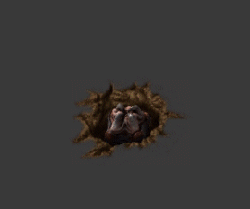 | A worm'south attack blitheness. |
Nests
The spawn points of biters and spitters. While nests themselves are generally defenseless, the enemies they release over time effectively serve as a grade of guards to distract the player and any nearby turrets, and are often accompanied past worms. Nests exposed to pollution will use it to send enemies to join attacks. Enemies non engaged in combat may seek out the nearest nest for protection.
The nests are highly resistant to fire and otherwise more often than not more resilient than a medium worm.
| Film | Name | Description |
|---|---|---|
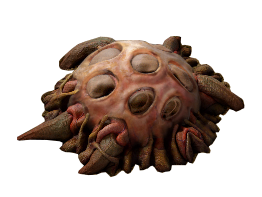 | Biter'due south nest |
Resistances:
|
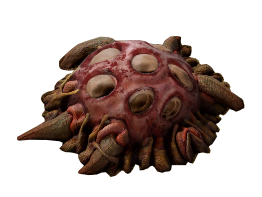 | Spitter's nest |
Resistances:
|
Expansions
Every 4-hour, a group of five-20 biters/spitters will leave their base to create a new base which will consist of as many worms/nests every bit there are members in the group. This group will search for a suitable spot that's iii-seven chunks away from existing bases. The interval between enemy expansions is global, and the higher enemy evolution, the shorter the interval is on average. Furthermore, with higher evolution, the groups are bigger on average.
Once they accept found a suitable spot, each biter/spitter in the group dies and forms a new nest or worm. Forming a new nest or worm will destroy annihilation that is in the style, which tin can include members of the expansion group. There is a delay between each member sacrificing itself for to create a worm/nest, so creating the new base from the expansion group can take quite a long fourth dimension, depending on the group size. Medium worms are merely formed if the current evolution is college than 0.three, big worms only if the current evolution is higher than 0.v and behemoth worms are just formed if electric current evolution is higher than 0.9. The game randomly chooses whether to form a new biter nest, spitter nest, small worm, or bigger worm if the evolution gene is loftier enough. [ii]
Defence
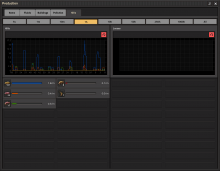
Nests spawn biters and spitters freely. Nonetheless, biters and spitters will only aggressively engage the histrion'due south manufacturing plant if the pollution cloud of the manufacturing plant reaches a nest because pollution is consumed to send biters or spitters to join the next attack. Every i to ten minutes (random) the mustered biters launch an attack. If not all biters accept arrived at the rendezvous point by that time, they will wait up to an boosted 2 minutes for stragglers. The assail then proceeds to their target over the shortest path possible, bookkeeping for terrain, simply not for actor entities that could pose an obstacle (like walls).
If there is a clear path somewhere effectually those obstacles, the biters will endeavor to go effectually. If there is no clear passage or a clear passage would hateful diffusive besides far from the original course, the biters will attack whatever is in their way to go through. This tin be exploited to an extent; creating mazes at regular intervals along a bulwark tin directly the biters through a gauntlet not dissimilar to belfry defense force.
However, if a biter comes in proximity of a military unit of measurement or construction, it will prioritize these and try to immediately attack them instead, over again trying to reach the new target over the shortest possible path with no also great detours, if possible.
Evolution
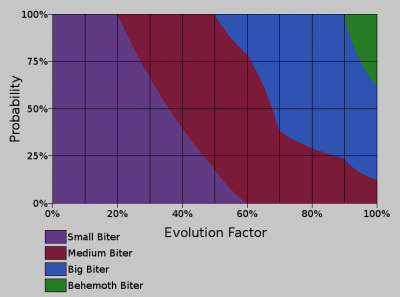
Spawn chances of biters from biter spawners by evolution cistron.
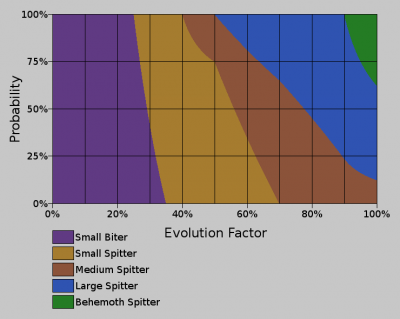
Spawn chances of spitters from spitter spawners by development cistron.
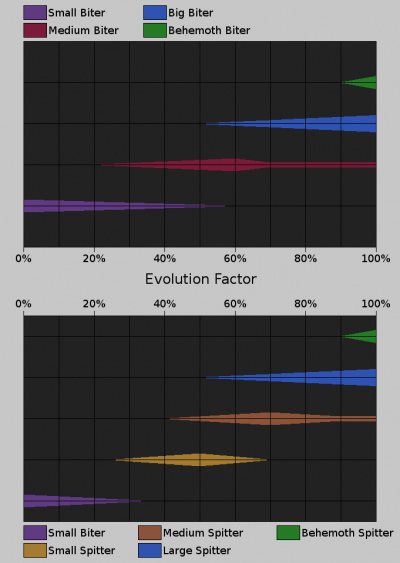
Weight graph of both spawners by development cistron. The values shown are primarily for indicating when certain types beginning and stop spawning, for actual chances refer to the tables or other charts.
The evolution gene is a global variable that determines what kind of biters volition exist spawned. You lot tin can check the variable in the dev panel via the following control (does not disable achievements):
/development
The evolution factor goes from 0 (non evolved at all) to 1 (maximal evolution). At the moment the evolution cistron tin can merely increment.
Besides choosing what kind of biter volition be spawned, the evolution factor also influences the spawning interval. This interval (spawning_cooldown in the enemy-spawner definition) is interpolated between 360 (0 evolution) and 150 (1 evolution) game ticks (= 6 to ii.v seconds).
Methods of increasing
The evolution gene is increased past three kinds of events:
- The passage of fourth dimension very slightly increases the development factor.
- The global pollution production increases the evolution factor.
- Destroying nests significantly increases the evolution cistron.
All these values are set in game.map_settings.enemy_evolution. From there they tin can exist inverse or modded.
The default settings are:
| Source per | Variable in enemy_evolution | Percent increase |
|---|---|---|
| 2d | time_factor | 0.0004% |
| i Pollution unit | pollution_factor | 0.00009% |
| Destroyed enemy spawner | destroy_factor | 0.2% |
Pollution product is the full pollution produced past buildings per tick, not the pollution spreading on the map, so it is not reduced by copse or other absorbers. eastward.k. : 10 boilers produce 300 pollution in one infinitesimal, raising the development cistron by effectually 0.027%.
The percentages are applied on the base of (1 - current_evolution_factor)². Then for example destroying enemy spawners in the beginning of the game results in increase of evolution gene by 0.002 (0.two%) while doing this when the evolution factor is 0.five the increase is only 0.0005 (0.05%).
This too means that the evolution factor approaches ane asymptotically - generally, increases by 0.9 or and so are very slow and the number never really reaches 1.0.
Spawn chances by evolution cistron
The probability charts show the chances of each type of biter/spitter for each spawner at all evolution levels.
Advanced: Evolution factor components and computation
This section has charts plotting the individual evolution gene components and discusses possibilities for manually estimating the evolution cistron.
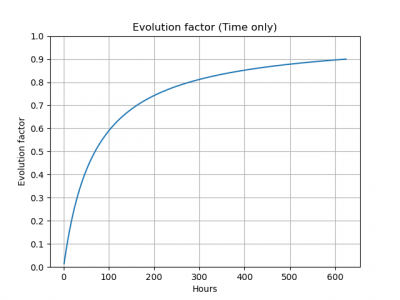
1. Single-component evolution cistron increase with time
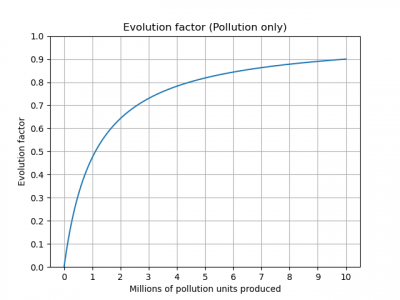
ii. Single-component evolution factor increase with pollution
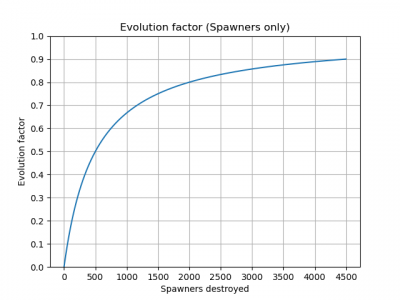
three. Unmarried-component evolution cistron increase with destroyed spawners
Notes
- Data from version ane.1.l.
- All charts end at approximately an evolution factor of 0.xc.
- The adding steps for time and spawner kills match those used past the game, then these charts should exist authentic. The pollution chart assumes a pollution production of 1000 units per second, and due to the recursive nature of the chart values volition slightly diverge at dissimilar pollution rates. The effect of this is negligible for any reasonable corporeality pollution production, however.
- Given that the game reports the actual development factor (console:
/development) whenever the player wishes, these charts are intended primarily to help estimate the impact of planned base expansions and similar activities on the evolution cistron's hereafter development.
Comments
These charts (click to enlarge) represent the situation where each development factor component (time, pollution, destroyed spawners) is the only component contributing to the development factor in that entire game. They are therefore non realistic, as in a typical game all three components will contribute, some at varying times and intensities.
Considering of how contributions to the evolution cistron (hereinafter, EF) are calculated (multiplied past (1 - current EF)), it is not possible to merely add the values indicated past these charts for a game's fourth dimension passed, pollution generated, and / or spawners destroyed so far to retrieve the total development gene.
For example, if 20 hours take passed (single-component EF =~ 0.25), 10 million pollution units were released (single-component EF =~ 0.fifteen), and 200 spawners were destroyed (single-component EF =~ 0.35), the actual evolution factor will not be (0.25 + 0.15 + 0.35 =) ~0.85.
However, the development factor will always exist less than the sum of all private components every bit indicated by these charts, and at least as high as the highest individual component. Thus, using the values from in a higher place, the EF will be at least 0.35 and less than 0.85. A smarter approach is required to compute the amount of pollution released.
Ciphering of bodily evolution factor
The actual EF can exist computed as follow :
1 - EF = (1 - E[t]) * (ane - E[p]) * (1 - E[southward]), where E[t], E[p], and E[s] are the single-component values from the pollution, time, and spawner charts, in that order.
A key observation in understanding where this formula comes from is that each incremental change of the evolution factor is effectively a multiplication of one - EF past a abiding (depending on the nature of the alter). For example, another way of saying that killing a biter nest augments evolution by 0.2% of one - EF, is to say that killing a biter nest multiplies one - EF past 0.998.
And then, like multiplication, evolution is, barring rounding errors, associative and commutative. The commutativity ways that the guild in which you take evolution-increasing actions does not thing, and along with the associativity results in the formula in a higher place.
That knowledge can also exist applied to compute the to a higher place charts exactly, or to compute a component of evolution without having to refer to the nautical chart at all. For example, pollution equally a function of fourth dimension just is 1 - 0.999996 ^ t where t is the time in seconds.
For the values from above, we can deduce the evolution factor 1 - EF = (1 - 0.25) * (1 - 0.xv) * (i - 0.35) = 0.75 * 0.85 * 0.35 = 0.41, which gives an development factor of 0.59.
This formula can also be used to gauge impact of future player activities on the EF: a gear up of deportment that is known to bring the evolution factor of a earth from 0 to EF(2) (eg using the above chart and formula) will bring it from EF(1) to 1 - (1-EF(i)) * (1-EF(ii))
For case, if the player planned to spend the next xx hours building upward their base, releasing 10 million pollution and destroying 200 spawners in the concurrently (i.due east., the same numbers as in the example above), and the EF at the starting time of this flow were, say, 0.55, then the estimated EF at its finish will be i - (1 - 0.55) * (1 - 0.59) = 0.81.
Gallery
-
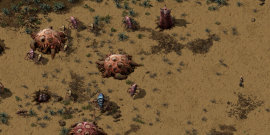
The player near some enemy nests and worms.
-
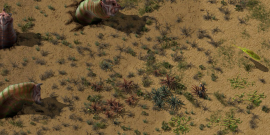
The thespian among acid puddles created by attacking worms.
-
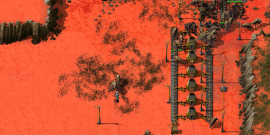
Both the player and some buildings getting attacked by biters.
-
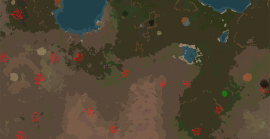
Enemy nests seen in a map generation preview (deathworld setting).
-
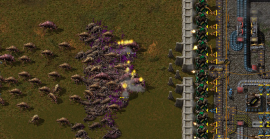
Line of gun turrets defending confronting biters.
-
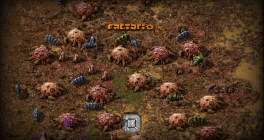
Enemies seen at the title screen.
History
- 0.17.0:
- Behemoth worm added.
- 0.15.0:
- Increased the damage, range, and wellness of worms.
- Decreased health and resist of Behemoth biters.
- 0.13.10:
- Biters and other units won't get aggressive equally a upshot of friendly-fire.
- 0.13.0:
- Large and behemoth enemies now spawn 50% slower.
- Changed the way development factor approaches the maximum (1).
- The addition of evolution factor was inverse from addition * (one - evolution) to improver * (one - development)^2
- This means that the progress gets more than slower towards the high values.
- 0.12.26:
- Running biters over with a vehicle will at present anger them in peaceful mode.
- 0.12.0:
- Updated sounds for enemies.
- 0.11.17:
- Items dropped by enemies(*) are at present nerveless automatically and from longer distances.
- 0.xi.six:
- Range of spitters is now 15, less than turrets.
- 0.eleven.0:
- Spitters added.
- Drawing of enemies optimised, so adding new colors does not impact VRAM.
- Claret splashes on death are now procedural.
- 0.9.0:
- Turrets no longer search for enemies when none are almost.
- Biters tin no longer destroy the shipwreck in the third new hope campaign.
- 0.8.ane:
- Further comeback to enemy AI.
- 0.8.0:
- Decreased the range of medium worm from 25 to 20.
- 0.7.two:
- Biter AI improved.
- 0.vii.1:
- Peaceful mode added for freeplay.
- 0.7.0:
- Enemy creepers were replaced past modest, medium and large biters.
- Enemy turrets were replaced by small, medium and big shooting worms.
- Enemies movement and attack in groups.
- Enemies wander around their base when they have nothing to practise.
- Enemies call for help when attacked.
- Enemies tin create new bases.
- Enemies can at present destroy all player creations they detect.
- 0.1.0:
- Introduced, called 'creepers'
Encounter too
- Damage
- Pollution
Source: https://wiki.factorio.com/Enemies

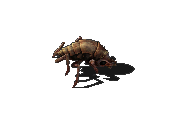
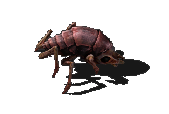
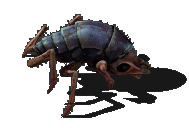
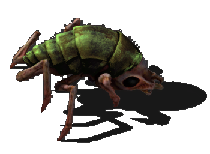
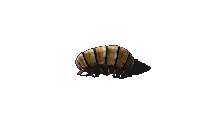
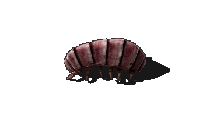
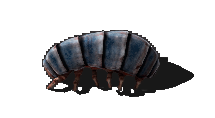
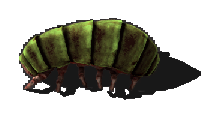
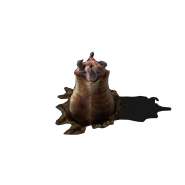
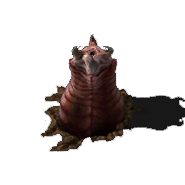
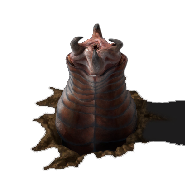
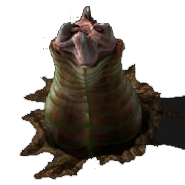
0 Response to "Easy Way to Kill a Nest Factorio"
Post a Comment